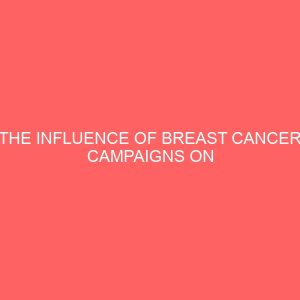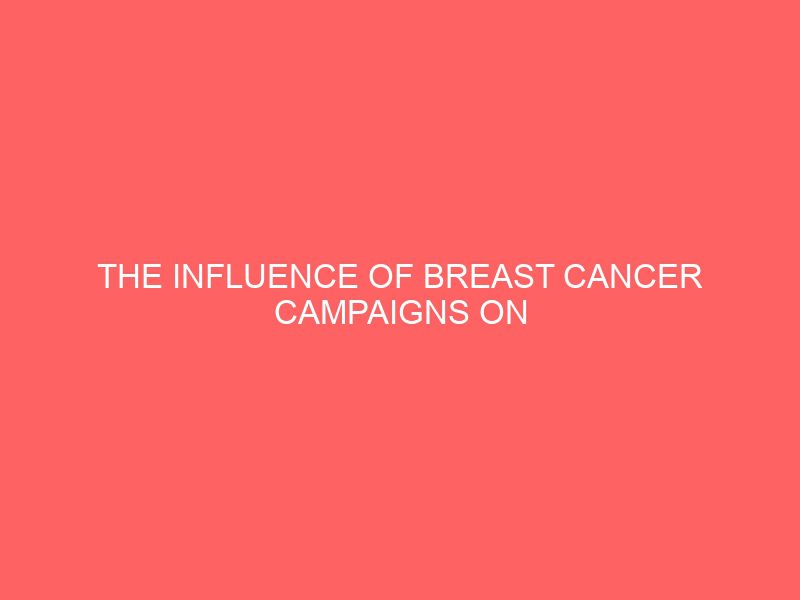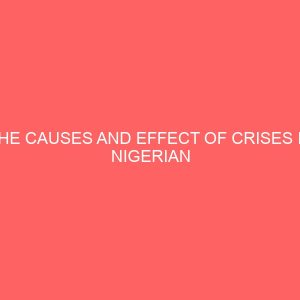Description
CHAPTER ONE
INTRODUCTION
1.1 Background of the Study
The entire human race is at the brink of total destruction because of the increasing susceptibility to cancer. Statistics emanating from different health organisations and agencies around the world indicate that there are over 16 million new cases of cancer globally. This figure, according to World Health Organization (WHO) 2011report, is likely to double in 2020 (Chustecka, 2011p.1). Over 16 million cancer cases have been predicted to occur in 2020 with 70 percent of these cases likely to take place in developing countries with Africa accounting for over 57 percent incidence rate and one million cases of breast cancer (Chustecka, 2011p.1).
The International Agency for Research on Cancer (IARC) gave an estimate of over 681,000 and 512,400 new cases of cancer in 2008 alone. These figures have increased to 1.4 million cases and 714,000 deaths in 2010 (IARC Report 2010 p.3). Unfortunately, it is projected by IARC that these numbers will double before 2030, because of the aging and growth of the population; unhealthy behaviours associated with lack of exercises, dieting, smoking, economic development and urbanization. According to this report, the factors mentioned above result in different types of cancers, such as cancer of the stomach, lungs, liver, uterus, kidney (renal cell carcinoma), blood cancer known as leukemia, sinuses and breast cancer. Breast cancer ranks the second most prevalent of all cancers worldwide after cancer of the lungs (World Cancer Report, 2011p.4).
Globally, there are over 1.2 million cases of breast cancer with 411,000 deaths annually. More than 56-60 percent of these deaths occur in developing countries including Nigeria (Akpo, Akhator & Akpo 2010 p.3). It is estimated that in every 100,000 Nigerian women, 116 of them have breast cancer and that more than half of the number have a very
high generic risk status and as such are vulnerable to the disease. (American Cancer Society, 2009 p.6). In addition, Akpo, Akhator and Akpo (2010 p.4), report that a recent oncological review of cases in Nigeria revealed that, breast cancer survival rate is less than 50 percent in Nigeria in contrast to 90 percent in developed countries. Bhopal (2002) refers to incidence as, the calculated risk of acquiring a new state or becoming sick within a certain period of time. He also notes that it is a frequency of occurrence of particular events at any given time. Despite the high incidence rate, the good news, however, is that experts believe that the high incidences of this disease can be reduced through aggressive enlightenment campaigns.
To this end, campaigns on breast cancer have been widely organized, not just in Benue state, but in Nigeria, Africa and the world over. Worthy of note are the step-down workshops at state levels developed by the wives of the Governors of the 36 states of the Federation, as a follow up on the action plan by the United Nations Population Fund (UNFPA) in April, 2008 at the Federal Capital Territory Abuja. The need to preserve lives and ensure a steady decrease in the level of maternal mortality resulting from breast cancer has been very salient. Also, the pet project of the Miss University Nigeria (MUN) which was an awareness and sensitization campaign against breast cancer was hosted in Makurdi, the Benue State capital in December, 2010. In fact, the MTN Foundation has breast cancer screening centers located within Teaching hospitals, Federal Medical Centers (FMCs) and state General hospitals across Nigeria (MTN Foundation, 2011 Report).
It is however, disheartening to note that despite several awareness and sensitization campaigns on the need for regular self examination as a preventive measure for breast cancer, so many women are still victims of the dreaded disease. As a matter of fact, breast cancer statistics indicate an increase, especially in developing countries that previously enjoyed a low incidence of the disease. It, therefore, means that accessibility to campaigns, awareness and knowledge level of risk factors, attitude towards campaigns and practices are highly
questionable. If women are aware and exposed to campaigns, whether or not they practice what they are taught is a determinant of the level of success of these campaigns.
A look at these significant campaigns organized by the National Breast Cancer Coalition, tagged “Not Just Ribbons” with emphasis on substantive issues such as genetic discrimination, access to medical care, patient?s rights, and anti-pollution legislation as against undue emphasis by business men on the pink ribbons; and Breast Cancer Action’s “Think Before You Pink” campaigns, give an understanding of what influence a well structured campaign can exert on people. (Sulik, 2010 p.366-368).
Campaigns must be structured in such a way as to accommodate factors which are vital in the fight against breast cancer. When access to the campaigns has been ensured, exposure at the right time and place is the next consideration after which the structuring of the campaign messages is done. These messages are meant to be the basic units of positive influence in the campaigns, as they will determine the knowledge level, attitude and practices of the target audience. It is the messages that will inform the women of the factors that cause breast cancer, the types of breast cancer, the need for self examination and early detection, the symptoms of breast cancer, treatment for it at the early stage and so on.
A good number of people might, therefore, underestimate or overestimate their generic risk status based on their level of awareness of the possible genetic mutations that can result in breast cancer. People who are not aware of generic factors will not understand that if a member of the family is diagnosed of breast cancer, every other female member stands a risk of developing breast cancer, thus the emphasis on periodic generic testing at the hospital, besides the prescribed self examination.
That is why Ferrandis, Andreu and Galdon (2002 p.27), citing (Sattin et al., 1985), explain that ?a family history of breast cancer is a clear risk factor for developing the disease. In effect, women who have a first degree relative with breast cancer have a 2- to 3-fold higher risk of developing the disease, while women who have both the mother and a sister with breast cancer are 14 times more likely to develop the disease than patients without a family history of breast cancer?.
This brings us to the efficacy of awareness in the campaign against breast cancer, with
the view that efforts at raising awareness will lead to greater knowledge and invariably lead
to earlier detection and a greater survival rate. This awareness level, however, has the
information angle where according to a Chinese proverb: ?the road to health is the road to
knowledge and ignoring knowledge is sickness?. Then there is the psychological angle where
too much of awareness causes guilt, fear, anxiety, depression and negative attitudes of self
isolation in breast cancer patients; where attitude developed is largely related to knowledge
acquired from social interactions, cultural values, personal interests and societal influence.
On this note, Eagly and Chaiken (1995 p.413) see attitude as a set of mental and neutral
readiness, organized through experience, which exerts a direct or dynamic influence upon a
response to all objects, and the situation with which it is related. Olson (2002 p.240-242),
Welch (2010 p.16) and Sulik (2010 p.74, 263), therefore, explain the attitude of women,
towards increased awareness on breast cancer thus:
An emphasis on educating women about lifestyle changes that may have a small impact on preventing breast cancer often makes women feel guilty if they do develop breast cancer. Some women decide that their own cancer resulted from poor diet, lack of exercise, or other modifiable lifestyle factor, even though most cases of breast cancer are due to non- controllable factors, like genetics or naturally occurring background radiation. Adopting such a belief may increase their sense of being in control of their fate. Increased awareness inadvertently increases victim blaming. Women who resist screening, mammography or breast self exams are subjected to social pressure, scare tactics, guilt, and threats from some physicians to terminate the relationship with the patient.
Similarly, the emphasis on early detection results in women blaming themselves if their cancer is not detected at an early stage.
The right attitude for women who have been diagnosed with breast cancer and those who are free should, therefore, be captured in the campaigns, given that several factors
contribute in the formation of negative or positive attitudes. Like Sunder, Adarsh and Pankaj (2009) explain, it is right to note that, society has cultural values and interests relating to health and health services which determine attitudes towards these services, and that these ideologies can be inimical to survival and so need to be addressed. Some women who are not able to adapt to societal pressures, develop negative attitudes towards medical services. But those who are able to adapt, resort to positive actions like being consistent with screening methods and as reports have shown, most women also resort to taking up social roles and advocacy in their fight against breast cancer, not only because of the health benefits but as a way of promoting their emotional recovery.
1.2 Statement of Problem
Several campaigns such as those organized by MTN Foundation, National Breast Cancer Coalition, Breast Cancer Action and the Miss University Nigeria have been organized in the bid to fight breast cancer, yet the current statistical data of maternal mortality resulting from breast cancer shows an increase. Cancer of the breast has the second highest cases of cancers annually with an incidence rate of over one million cases and is still the second principal cause of cancer mortality among women worldwide. (World Cancer Reports 2011p.4)
Breast cancer mortality rates are higher in developing countries as a result of late detection and diagnosis. Another reason has been identified as due to lack of knowledge about genetic risk factors for breast cancer. Also, social factors such as lack of awareness and lack of knowledge about the disease, suspected poor attitudes towards Breast Self Examination (BSE), Clinical Breast Examination (CBE), Mammography and other screening methods. These explain the fact that breast cancer is not well understood by women. And as such, there is the need for information and enlightenment to ensure early presentation at the hospital. The increased mortality rate is, also, attributable to the lack of periodic practice of early detection methods, like mammography and the lack of screening facilities. (Akpo, Akhator & Akpo 2010 p.3)
The MTN Foundation, National Breast Cancer Coalition, Breast Cancer Action and the Miss University Nigeria campaigners do not seem to know whether to attribute this increase in death rate to inefficiency in campaign message delivery or timing for target audience in campaign slots. Also, they do not know whether to blame it on audience members? predispositions towards vital instructions and teachings adopted in the breast cancer campaigns. However, some observers believe that any campaign aimed at fighting this deadly disease must have all it takes to increase knowledge, change attitude and enhance practice of screening methods among the audience. According to them, except there is a significant change in the attitude of those exposed to breast cancer campaigns, the entire exercise will amount to futility. This is the crux of the study. This study, therefore, was aimed at finding out the extent to which women in Benue State are exposed to breast cancer campaigns and how these campaigns have increased their awareness and knowledge level about breast cancer risk factors, and preventive measures.
1.3 Objectives of the Study
The major purpose of this study is to discover how breast cancer campaigns have influenced the knowledge, attitude and practice among women in Benue State towards breast cancer prevention, detection and treatment. Therefore, the objectives of this study are to:
1. Determine the level of awareness about campaigns on the causes of breast cancer, prevention, early detection and treatment among women in Benue State.
2. Find out the extent to which women in Benue State are exposed to breast cancer campaigns.
3. Establish whether the knowledge level of women in Benue State, on breast cancer risk factors, prevention, early detection and treatment has increased due to their exposure to the campaigns.
4. Find out the attitude of women in Benue State towards breast cancer campaigns on prevention, early detection and treatment.
5. Ascertain the extent to which they practice Breast Self Examination (BSE), Clinical Breast Examination (CBE), Mammography and Genetic testing due to their exposure to breast cancer campaigns.
1.4 Research Questions
The following research questions were directly drawn from the objectives of the study.
1. What is the level of awareness among women in Benue State, about campaigns on the causes, prevention, early detection and treatment of breast cancer?
2. To what extent are women in Benue State exposed to breast cancer campaigns?
3. Has the knowledge level of women in Benue State, on breast cancer risk factors, prevention, early detection and treatment increased due to their exposure to the campaigns?
4. What is the attitude of women in Benue State towards breast cancer campaigns on the prevention, early detection and treatment?
5. To what extent do they practice Breast Self Examination (BSE), Clinical Breast Examination (CBE), Mammography and Genetic testing as a result of their exposures to breast cancer campaigns?
1.5 Significance of the Study
The significance of this study to the media managers, health organization and agencies, academic community and the general society cannot be over emphasized.
Drawing from this study, media professionals who are involved in breast cancer campaigns will know the extent to which such campaigns influence knowledge, attitude and practice of the audience towards prevention, early detection and treatment of breast cancer. The study emphasized the need for aggressive campaigns relative to appropriate timing, simplicity of campaign messages and influence of the campaigns.
The Ministry of Health and other health organizations and agencies (local and international) will equally find the outcome of this study interesting. Given the scope of this study, current statistics were provided on the knowledge, attitude and practice level of breast cancer preventive measures among women in Benue State. Again, statistical data on mortality rate might stir up concerns for better promotion of knowledge on self examination and early detection; placing emphasis on prevention rather than cure. When this is achieved, increase in death rate would have been reduced.
The study embraced both rural and urban populations in Benue State in contrast to other works that dwelt only on rural and uneducated women. Also, studies surveying Benue State on breast cancer awareness and sensitization are few. This study, therefore, gave attention to health communication in the state.
Theoretically, this study provides an academic platform for testing claims put up by some theories on attitude and behavioural change.
Finally the study is a contribution to the academia. It will serve as a reference tool for further studies on the topic since one of the serious problems that have been identified in the academic community in Nigeria is limited data base in research. In mass communication, health communication related studies have not equally received serious attention despite the
huge resources thrown in this area. This study will, therefore, contribute to the limited pool of literature in health communication.
1.6 Scope and Limitations of the Study
The study covers the women in Benue State from ages 15 and above. It looks at the influence of breast cancer campaigns on knowledge, attitude and practice among these women. The study covers a total of 11 local government areas, randomly selected from the 23 local government areas of the state drawn from the three senatorial zones of the state.
This study is, however, restricted to opinions from the questionnaire irrespective of different individual motives in providing responses. Also, health responses on audience breast cancer status were based on audience self believe and examination and were not at all certified by medical doctors that they were free or infected. So based on what they felt, they provided answers.
The study was also limited by time available to carry out the research. The available time was not adequate given that several other activities had to be scheduled within the same period.
1.1 Operational Definition of Terms
Breast Cancer: a disease condition that affects the breast of women in Benue State. Campaigns: these are media programmes that are aimed at fighting against breast cancer by informing women in Benue State on the dangers and how it can be prevented, detected or treated
Influence: this refers to how the campaigns are able to bring about changes in the knowledge, attitude and practices among the women in Benue State.
Attitudes: the disposition of women in Benue State towards breast cancer prevention, early detection and treatment.
Knowledge: the level of technical know-how of women in Benue State on breast cancer campaigns .relative to prevention, early detection and treatment.
Practices: all conscious efforts by the women in Benue State to fight breast cancer through Breast Self Examination (BSE), Clinical Breast Examination (CBE), Mammography and Genetic testing, as a result of their exposure to breast cancer campaigns.
Benue women: all females in Benue State between ages 15 and above







